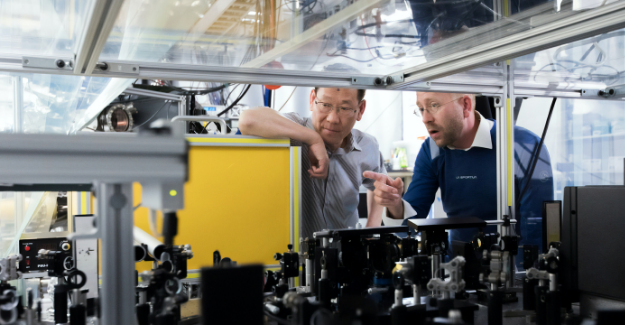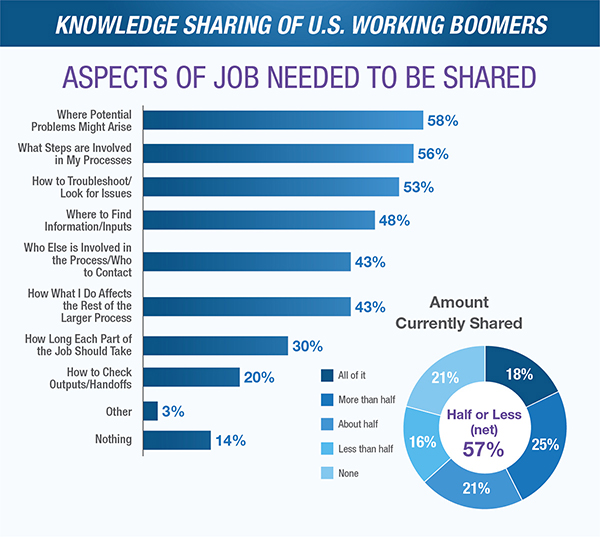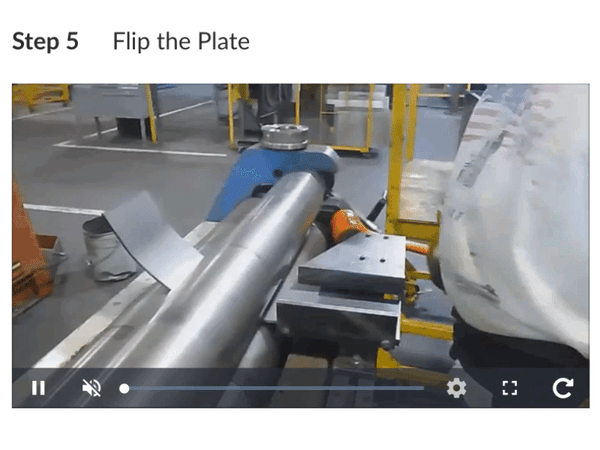
Training
6 min read
How to Capture Expert Knowledge Before it's Lost

It’s no secret. Manufacturers are coping with a massive wave of retirements. With over a quarter of the workforce over the age of 55, many workers are leaving their jobs with a wealth of knowledge and experience.
This “brain drain” (also referred to as the “silver tsunami”) is creating a skills gap for the industry, with some companies losing decades of investment in their workforce. It’s estimated that the skills gap costs companies $3,000 per existing employee.
Nevertheless, capturing expert knowledge before it retires is still a challenge for most manufacturers. A recent survey found that 57% of Baby Boomers have shared less than half of the knowledge needed to perform their job responsibilities when they retire. More shocking, 21% have shared none of their knowledge — almost a quarter of a generation’s expert knowledge, which will likely be retiring in the coming years. It’s time for companies to do more to protect their organization and proactively capture expert knowledge before it’s too late.
At Dozuki we specialize in knowledge management and documentation. After working with hundreds of organizations, we’ve developed proven strategies to capture expert knowledge and leverage it for generations to come.
Record the Work in Action
Your experts are busy. They’re spread thin between troubleshooting problems, performing a variety of tasks, and training employees. Instead of asking them to write down their vast amounts of knowledge and know-how, take time to observe experts during key procedures and record the process in a detailed fashion.
"Experts are already busy doing their jobs, they can’t spend the time they need to properly train new hires."
Operational Technology Manager, 3M
One way to circumvent this problem is to record the work in action. Take detailed notes of a process and capture as much information as possible. Capture images and videos of the work, and then write down the important details later.
Record Troubleshooting Techniques
Some of the most valuable tribal knowledge in manufacturing is the ability to troubleshoot problems as they arise, such as equipment failures or complex changeovers. Still, most companies fail at capturing this type of implicit knowledge.
The unstructured knowledge and solutions that live in the heads of experienced employees is some of the most valuable, but it’s incredibly difficult to capture. By creating a central location for common questions and issues, it becomes easier to unlock. This allows you to tap into the collective knowledge of your workforce, rather than relying on individual experts.
Create Co-Mentorship Programs
The incoming, younger workforce is thoroughly skilled in digital user interfaces — earning them the title of "digital natives." Companies can find success at the crossroads of retiring experts and these incoming workers.
These “digital natives” expect all of their learning and training to take place through a screen. Manufacturers can benefit from this. It's time to lean into scalable, digital solutions which capture the knowledge of retiring workers and efficiently train the next generation of manufacturers.
This allows both generations to learn from each other. Tenured employees will benefit from the digital competency of the new workforce. New hires will gain firsthand experience and feel confident at their job from day one.
Make Knowledge Easy to Document
This may sound obvious, but many companies are still using antiquated methods for documentation. Inefficient paper-based systems and clunky software tools make recording knowledge a pain.
Many times, access to documentation is the biggest obstacle to an employee’s success. When information is difficult to access, employees are discouraged from following established standards and create risk by trying to figure things out on their own.
When it’s quick and easy to capture expertise, sharing information becomes an integral part of company culture. Look for digital tools that make combining photos, videos, and written text into a procedure painless.
Leverage Expert Knowledge in Training
Traditional training methods are failing because they rely on an abundance of mentors to train new hires. As mentors retire, companies need to supplement traditional training methods with digital solutions.
How companies capture and leverage this knowledge will impact the success of their workforce for generations to come. Now’s the time to adapt to the shifting workforce and find digital tools that communicate clearly and regularly reinforce knowledge.
“The core elements of learning haven’t really changed. What we’ve found is everyone wants to learn from the expert, everyone wants visuals, and everyone needs repetition and practice.”
Operational Technology Manager, 3M
Topic(s):
Training
Related Posts
View All Posts
Training
Breaking Down the Skills Gap: Tribal Knowledge
7 min read
As the skills gap widens and more employees retire, decades of experience and company investment is predicted to walk out the door. With nearly ten thousand people turning...
Continue Reading
Training
What is Tribal Knowledge?
5 min read
Many industrial businesses have heard of the dangers of relying on tribal knowledge. But what exactly does tribal knowledge mean? How does tribal knowledge impact my...
Continue Reading
Industry News
How Connected Worker Solutions Combat Worker Shortages
6 min read
The manufacturing sector has always played a crucial role in the economy. But our industry has been grappling with a notable shortage of labor in recent years. This...
Continue Reading





